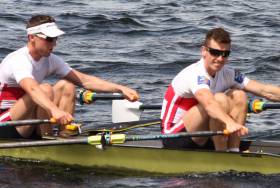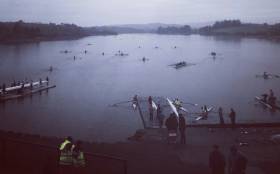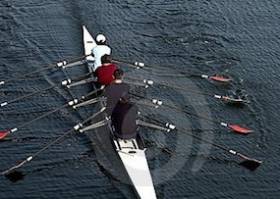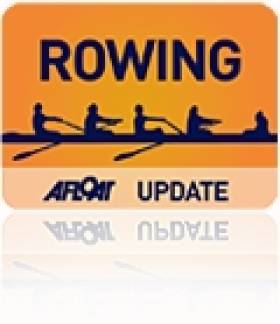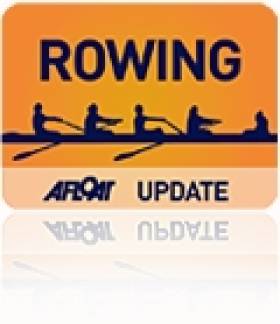Displaying items by tag: National Rowing Centre
Mark O'Donovan Faster Than Gary O'Donovan at Rowing Trial (Update)
#Rowing: Mark O’Donovan was first and Shane O’Driscoll second at the Ireland Assessment at the National Rowing Centre today – ahead of Olympic medallist Gary O’Donovan, who was the third-fastest lightweight and fourth overall. Heavyweight competitor Sam McKeown, who recently broke six minutes for 2,000 metres on the ergometer, was third and Daire Lynch, who is just moving out of junior ranks, an impressive fifth. The tests were run over six kilometres. Paul O’Donovan, the top lightweight, has exams and did not attend.
The top woman was Sanita Puspure, with Denise Walsh almost a minute further back. The women’s pair of Aifric Keogh and Aoife Feeley won their battle with the under-23 unit of Amy Mason and Tara Hanlon, but by a small margin.
Irish Assessment, National Rowing Centre (Selected Results; Six Kilometres)
Saturday
Men
Single Sculls – Heavyweight: 1 S McKeown 23 mins 57 seconds, 2 D Lynch 24:15, 3 T Oliver 24:17. Lightweight: 1 Mark O’Donovan 23:53, 2 S O’Driscoll 23:56, 3 G O’Donovan 24:09.
Women
Single Sculls – 1 S Puspure 25:12, 2 D Walsh 26:07, 3 A Keogh, A Feeley (pair) 26:25, 4 T Hanlon, A Mason (u23 pair) 26:28, 5 E Hegarty 27:05.
Sunday
Men: 1 S McKeown, T Oliver 21:29. Women: Four 24:01, 2 Puspure 25:18, 3 Walsh 26:06, 4 Pair 26:50.
UCC Eight Impress at Muckross Rowing
#Rowing: UCC’s senior eight set an excellent time of 10 minutes four seconds for the course length of approximately three kilometres at the Muckross Head of the River at the National Rowing Centre. The young crew, stroked by Ciarán Higgins, was far and away the fastest crew of the day. The Skibbereen/UCC women’s composite eight set a time of 11 minutes 56 seconds, three seconds faster than that of Cork Boat Club. Conditions were excellent, especially in the morning. SEE ATTACHED RESULTS.
Muckross Head of the River, Selected Results
Men
Eight – Senior: UCC 10 minutes 4 seconds; Commercial 10:42; Cork/UCC 11:12. Club One: Commercial 11:43. Club One/Masters: Castleconnell, Shandon, Univ of Limerick 11:43. Junior 18: Commercial 11:01.
Four – Senior: Cork 11:23.
Pair – Senior: Commercial (Acheson) 11:52. Inter: Commercial (Beggan) 11:46.
Sculling – Quadruple: Shandon/UCC 11:21. Junior 18: Castleconnell 11:35. Jun 16, coxed: Shandon 11:23.
Single: UCC (R Byrne) 12:08.
Women
Eight – Skibbereen/UCC 11:56. Junior 18: Lee 13:28
Sculling - Quadruple – St Michael’s 13:13
Double – St Michael’s 12:46.
Single - Senior: Skibbereen (O Hayes) 13:48. Junior 18: Lee (M Cremen) 13:51.
Under-23 Quadruple Fastest in Finals at National Rowing Centre
#Rowing: The men’s under-23 quadruple had a narrow win over the lightweight men’s four at the Ireland Trial at the National Rowing Centre in Cork today. The crew of Jack Casey, Barney Rix, Dan Buckley and Sam McKeon had .4 of a second over the lightweights in the first race in the finals session. Gary O’Donovan, in a lightweight single, won the second race. Siobhán McCrohan raced in the finals, but her selection race-off with Denise Walsh did not happen as Walsh withdrew, ill.
Ireland Trials, National Rowing Centre, Cork (Selected Results; Per Centage of Projected World Best Time for this boat)
Saturday – Men, Junior, Pair – Time Trial: 1 Presentation, Cork A (O’Keeffe, Kennelly) 7 mins 41.8 sec (85.53 per cent), 2 Portora (Armstrong, Johnston) 7:42.3 (85.44), 3 St Michael’s A (B McKeon, T McKeon) 7:44.4 (85.07). A Final: 1 Armstrong, Johnston 8:32.2 (77.12), 2 McKeon, McKeon 8:39.7 (76.0), 3 O’Keeffe, Kennelly 8:43.8 (75.41).
Single Sculls – Time Trial: 1 D Lynch 7:59.9 (86.26), 2 R Byrne 8:03.2 (85.68), 3 D Mitchell 8:12.1 (84.13). A Final: 1 Lynch 8:35.6 (80.29 per cent), 2 Byrne 8:40.9 (7i.48), 3 Mitchell 8:53.6 (77.59). B Final: F O’Sullivan 8:50.8 (77.99).
Women – Junior – Pair – Time Trial: 1 Cork A (Mason, Hanlon) 9:05.2 (79.97), 2 Methodist A (McIntyre, McBrinn) 9:22.5 (77.51), 3 Portora (Kelly, Elliott) 9:24.4. A Final: Mason, Hanlon 9:21.3 (77.67), 2 McIntyre, McBrinn 9:35.9 (75.7), 3 Shannon (Tully, Carmody) 9:40.5 (75.11), 4 Kelly, Elliott 9:40.8 (75.07). B Final: Shandon/Lee (Heaney, Kovacs) 9:43.4 (74.74).
Single Sculls – Time Trial: 1 H Scott 9:03.7 (83.5), 2 E Hegarty 9:04.8 (83.33), 3 A Casey 9:11.9 (82.26). A Final: 1 Hegarty 9:37.7 (78.59), 2 Scott 9:47.7 (77.25), 3 Casey 10:00.1 (75.65). B Final: F Chestnutt 10.02.9 (75.3).
Sunday – Senior, Under-23 and Junior Time Trial (men unless stated; selected results): 1 Lightweight Four 6:39.9 (85.03), 2 Under-23 Quadruple 6:39.9 (82.52), 3 Junior Double (Byrne, Lynch) 7:21.3 (86.1); 5 Lightweight Single (G O’Donovan) 7:43.2 (85.9), 6 Jun Pair (Armstrong, Johnston) 7:50.6 (83.94); 8 Jun Women’s Double (Hegarty, Scott) 8:10.4 (85.65); 10 Women’s Pair (B O’Brien, L Kennedy) 8:17.4 (81.21), 11 Women’s Single (S Puspure) 8:18.2 (85.3), 11 Jun Single (D Mitchell) 8:20.5 (82.72), 13 Women’s University Single (M Dukarska) 8:37.1 (82.18), 14 Women’s Lightweight Single (S Jennings) 8:54.3 (81.98), 15 Jun Women’s Pair (Mason, Hanlon) 8:58.1 (81.03).
Finals – Race One: 1 U-23 Quad 6:29.4, 2 Light Four 6:29.8, 3 Junior Double 7:05.1. Race Two: Light Single (G O’Donovan) 7:26.2, 2 Jun Pair 7:34.5, Jun Women’s Eight 7:35.6, 4 Lightweight Women’s Single (S McCrohan) 8:29.2. Race Three: Lightweight Men’s Single (C Beck) 7:50.7, 2 Light Single (D O’Connor) 7:52.7, 3 Jun Women’s Double 7:53.7, 4 Puspure 8:00.4. Race Four: 1 Dukarska 8:17.4, 2 Jennings 8:20.2, 3 Jun Women’s Pair (Mason, Hanlon) 8:35.2.
Ireland Trials Adopt Schedule Change
#Rowing: The final schedule for the Ireland trials this weekend at the National Rowing Centre has been released. The adult events are now sited primarily on the Sunday, with just the men’s under-23 heavyweight double sculls being added to the big junior programme on the Saturday, March 19th. The first time trials, for junior men’s pairs, start earlier than originally scheduled, at 8.30 am because of concerns about the weather. Finals for juniors are scheduled for the Saturday afternoon.
Ireland Rowing Trial Cancelled
#Rowing: The Ireland trials set for this weekend have been cancelled. Weather conditions at the National Rowing Centre in Cork would not have been suitable. The athletes set to compete will next trial at the Irish Indoor Rowing Championships in Limerick on January 23rd. The weights allowed will 73kg for lightweight men and 59.5 kg for lightweight women, which are those carried forward from the proposed December trial.
Ireland Trial in Doubt
#Rowing: The Ireland trial this weekend is in doubt. The National Assessment has been fixed for the National Rowing Centre at Farran Wood on Saturday and Sunday, December 19th and 20th, but the weather forecast is not good. Rowing Ireland has announced that a decision will be made on Wednesday. “The conditions at present do not look great. We are keeping a very close eye on the wind forecast as well as the amount of flood water coming into the lake.”
Muckross Head of the River Falls to Bad Forecast
#Rowing: The Muckross Head of the River, fixed for the National Rowing Centre in Cork on Saturday, has been cancelled. The organisers say the bad weather forecast, including high winds, would have presented an unacceptable safety risk. The Head of the Shannon, also set for Saturday, has already been cancelled.
Irish Rowing Championships Draw Huge Entry
#Rowing: The 2015 Irish Rowing Championships will be held at the National Rowing Centre in Farran Wood, Cork from Friday 10th July to Sunday 12th July.
This year’s Championships features a mammoth entry of a total of 893 crews, with races running from 9am-5pm on Friday, 8:30am-6:30pm on Saturday and 8:30am-5pm on Sunday.
This event will attract over 3,000 competitors and approximately 10,000 spectators over the three day duration of the regatta and it is the premier domestic event of the rowing season.
The Championships are arguably Ireland's largest annual water sports event and are also the most significant All-Ireland sporting championship to be held annually in Cork. It promises to be a very exciting weekend of competitive rowing.
#ROWING: Siobhán McCrohan and Sinéad Jennings dead-heated in the shoot-out for the place in the lightweight single sculls at the European Championships. The race was held over 1500 metres because of a powerful tailwind at the National Rowing Centre, and neither sculler could draw clear of the other in a stirring contest. McCrohan started and finished well, while Jennings did well in the middle stages. The two are set to race again over 1500 metres on Friday or Saturday.
Skibbereen Regatta Cancelled - For Second Time
#ROWING: Skibbereen Regatta, set for Sunday (May 3rd) at the National Rowing Centre, has been cancelled because of an adverse weather forecast – for a second time. The prediction of gusting winds from the south east was bad news for a regatta with a very big entry of small boats. The Grand League event had originally been fixed for April 11th and 12th but also fell victim to the forecast of bad weather. This leaves just two Grand League rounds on the calendar, Dublin Metropolitan and Cork Regatta.


























